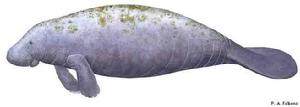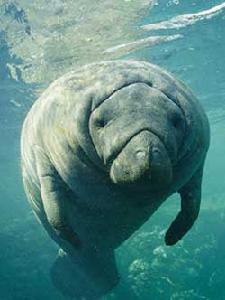名稱
 北美海牛
北美海牛--------------------------------------------------------------------------------
學名 - 英文名:
Trichechus manatus Linnaeus, 1758 - West Indian manatee
特徵
特徵描述:
West Indian manatees are rotund and have long flexible forelimbs and rounded, paddle-like tails. The head is small, with no discernible neck, and the body exhibits numerous folds and fine wrinkles. The squarish, thickened snout has fleshy mobile lips (with stout bristles on the upper lip) and 2 semi-circular nostrils at the front. The skin has fine hairs sparsely distributed over its surface. Each flipper has 3 or 4 fingernails at the tip. The tail stock is not laterally compressed into a peduncle. The colour of the skin is generally grey to brown, often with a green tinge caused by algal growth. The short hairs are colourless. calves appear to be a darker shade of grey, almost black. There are 5 to 7 pairs of bicuspid post-canines in each jaw. When forward teeth are worn or lost, they are replaced from behind. At birth, each jaw also has 2 vestigial incisors, which are lost as the animal ages.
容易混淆為:
The West Indian manatee is the only sirenian throughout its range, with the possible exception of the area around the mouth of the amazon river. In this region, Amazonian manatees can be distinguished by their smaller size, more slender body, smooth skin, lack of nails on the flippers, and their tendency to have light belly and chest patches.
個體大小:
Most adults are up to 3.5 m (3.9 m maximum) long and weigh up to 1590 kg. Newborns measure about 120 cm and weigh about 30 kg.
地理分布
地理分布:
West Indian manatees are found in coastal marine, brackish, and freshwater areas of the tropical and subtropical southeastern United States, Gulf of Mexico, Caribbean Sea, and Atlantic coast of northeastern South America. There are 2 subspecies: the Florida manatee (T. m. latirostris) from Louisiana to Virginia in the northern Gulf of Mexico and southeast United States, and the Antillean manatee (T. m. manatus) from northern Mexico to central Brazil and the islands of the Caribbean. Recently, a few manatees transplanted into the Panama Canal may have passed through the locks and made it to the Pacific side.
生物學及行為:
Manatees are slow-moving and lethargic; they are seen mostly alone or in groups of up to 6. Larger groups are occasionally seen. For instance, during cold weather, large aggregations assemble near sources of warm water (such as power plant outfalls) in Florida. West Indian manatees breed throughout the year, with a peak, at least in Florida, in the spring and summer. Generally, a single calf is born after a gestation period of at least 12 months. These animals are vegetarians, feeding on aquatic plants, such as water hyacinths and marine seagrasses. At times in some areas, they also eat algae, parts of mangrove trees, floating and shoreline vegetation, invertebrates such as tunicates, and fish they remove from fishing nets.
利用價值:
West Indian manatees are endangered. Heavy hunting pressure in the past has reduced the population considerably. Currently, human-induced problems, especially loss of habitat from unchecked development and death or injury from collisions with fast-moving boats, eminently threaten this species with extinction.
IUCN等級:
Vulnerable.
異名:
Trichechus manatus Linnaeus, 1758
俗名:
Lamantin des Cara*bes 【法語】 Vaca marina del Caribe 【西班牙語】 West Indian manatee 【英語】 West-Indische zeekoe 【荷蘭語】
FAO物種代碼:
TRIC Tric 1【FAO Species code】 WIM 【FAO Species code】

